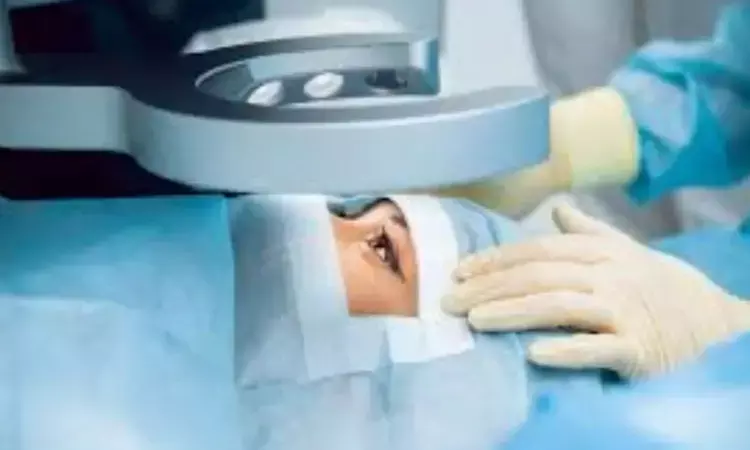- Home
- Medical news & Guidelines
- Anesthesiology
- Cardiology and CTVS
- Critical Care
- Dentistry
- Dermatology
- Diabetes and Endocrinology
- ENT
- Gastroenterology
- Medicine
- Nephrology
- Neurology
- Obstretics-Gynaecology
- Oncology
- Ophthalmology
- Orthopaedics
- Pediatrics-Neonatology
- Psychiatry
- Pulmonology
- Radiology
- Surgery
- Urology
- Laboratory Medicine
- Diet
- Nursing
- Paramedical
- Physiotherapy
- Health news
- Fact Check
- Bone Health Fact Check
- Brain Health Fact Check
- Cancer Related Fact Check
- Child Care Fact Check
- Dental and oral health fact check
- Diabetes and metabolic health fact check
- Diet and Nutrition Fact Check
- Eye and ENT Care Fact Check
- Fitness fact check
- Gut health fact check
- Heart health fact check
- Kidney health fact check
- Medical education fact check
- Men's health fact check
- Respiratory fact check
- Skin and hair care fact check
- Vaccine and Immunization fact check
- Women's health fact check
- AYUSH
- State News
- Andaman and Nicobar Islands
- Andhra Pradesh
- Arunachal Pradesh
- Assam
- Bihar
- Chandigarh
- Chattisgarh
- Dadra and Nagar Haveli
- Daman and Diu
- Delhi
- Goa
- Gujarat
- Haryana
- Himachal Pradesh
- Jammu & Kashmir
- Jharkhand
- Karnataka
- Kerala
- Ladakh
- Lakshadweep
- Madhya Pradesh
- Maharashtra
- Manipur
- Meghalaya
- Mizoram
- Nagaland
- Odisha
- Puducherry
- Punjab
- Rajasthan
- Sikkim
- Tamil Nadu
- Telangana
- Tripura
- Uttar Pradesh
- Uttrakhand
- West Bengal
- Medical Education
- Industry
Epithelial-related complications more prevalent in older patients after recovery from SMILE

Small incision lenticule extraction (SMILE) is a laser refractive surgery to correct myopia. Using a femtosecond laser, a small intrastromal lenticule is created and manually extracted through a small incision. Unlike other refractive surgical techniques, SMILE does not involve the creation of a corneal flap, providing several advantages over laser assisted in situ keratomileusis (LASIK) with respect to managing postoperative corneal-related complications. Although epithelial-related complications after LASIK have been described in several studies, the incidence of epithelial-related complications following SMILE is not as well documented. The study by Moshirfar et al reported a single-site five-year experience with the incidence and management of only epithelial-related complications after SMILE.
A retrospective, single-site study analyzed patients who underwent SMILE at Hoopes Vision Clinic in Draper, Utah, from June 2017 to February 2023. Demographic data and preoperative parameters were reviewed. Postoperatively, patients were assessed for visual acuity and complications at different time points. Statistical analyses were conducted between the control and complication groups.
Four hundred and thirty-two eyes of 220 patients received SMILE. Postoperative epithelial-related complications were indicated in 68 (15.7%) eyes, including anterior basement membrane (ABM) changes (five [1.2%]) eyes), epithelial ingrowth (nine [2.1%] eyes), erosion (two [0.5%] eyes), rough epithelium (18 [4.2%] eyes), epithelial defect (12 [2.8%] eyes), diffuse lamellar keratitis (DLK) secondary to epitheliopathy (two [0.5%] eyes), microstriae secondary to epitheliopathy (four [0.9%] eyes), interface debris (21 [4.9%] eyes), and incisional fibrosis (one [0.2%] eye).
There was a statistically significant difference in age, with older patients more likely to develop epitheliopathy postoperatively (P = 0.001).
Additionally, patients with epithelial-related complications were more likely to receive photorefractive keratectomy (PRK) enhancement after SMILE than the control (P = 0.001).
However, there was no statistical difference in uncorrected distance visual acuity (UDVA) better than 20/20 and corrected distance visual acuity (CDVA) between the complications group and the control at the last postoperative visit (P = 0.974 and 0.310, respectively).
There was no statistically significant difference in the safety and efficacy indices between the complications and control group (P = 0.281 and 0.617, respectively).
In this retrospective chart review, various epithelial-related complications following SMILE were analyzed. Of the 10 complication groups, these four were the most cited: interface debris, rough epithelium, epithelial defect, and epithelial ingrowth.
This study examined the incidence and management of epithelial-related complications after SMILE. Despite the development of such complications, satisfactory visual prognoses could be achieved with various strategies. The study found that epithelial-related complications were more prevalent in older patients and predisposed patients to require future PRK enhancements after recovery from SMILE.
Source: Moshirfar et al; Clinical Ophthalmology 2023:17 2777–2789
Dr Ishan Kataria has done his MBBS from Medical College Bijapur and MS in Ophthalmology from Dr Vasant Rao Pawar Medical College, Nasik. Post completing MD, he pursuid Anterior Segment Fellowship from Sankara Eye Hospital and worked as a competent phaco and anterior segment consultant surgeon in a trust hospital in Bathinda for 2 years.He is currently pursuing Fellowship in Vitreo-Retina at Dr Sohan Singh Eye hospital Amritsar and is actively involved in various research activities under the guidance of the faculty.
Dr Kamal Kant Kohli-MBBS, DTCD- a chest specialist with more than 30 years of practice and a flair for writing clinical articles, Dr Kamal Kant Kohli joined Medical Dialogues as a Chief Editor of Medical News. Besides writing articles, as an editor, he proofreads and verifies all the medical content published on Medical Dialogues including those coming from journals, studies,medical conferences,guidelines etc. Email: drkohli@medicaldialogues.in. Contact no. 011-43720751


